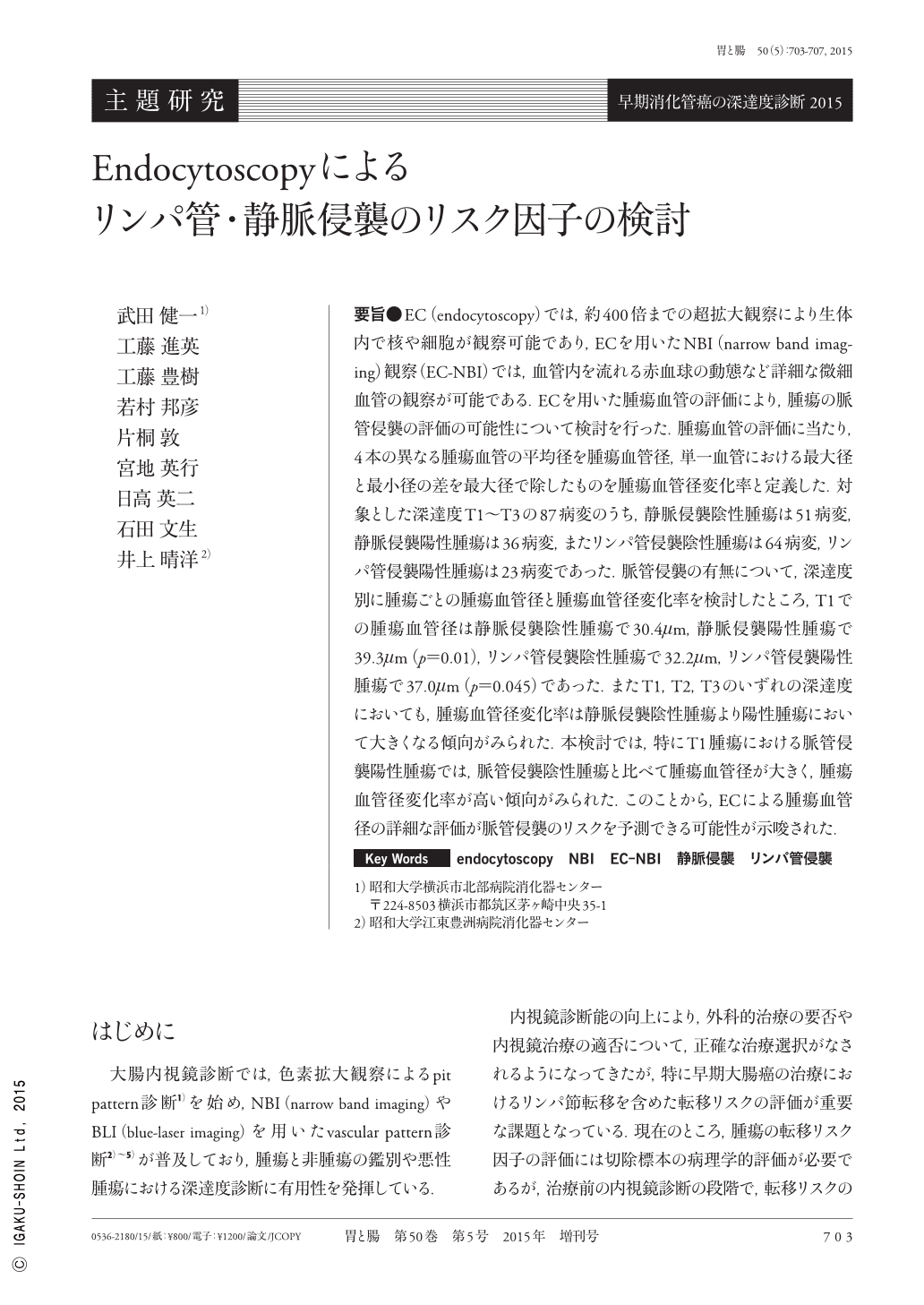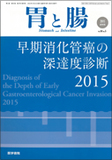Japanese
English
- 有料閲覧
- Abstract 文献概要
- 1ページ目 Look Inside
- 参考文献 Reference
要旨●EC(endocytoscopy)では,約400倍までの超拡大観察により生体内で核や細胞が観察可能であり,ECを用いたNBI(narrow band imaging)観察(EC-NBI)では,血管内を流れる赤血球の動態など詳細な微細血管の観察が可能である.ECを用いた腫瘍血管の評価により,腫瘍の脈管侵襲の評価の可能性について検討を行った.腫瘍血管の評価に当たり,4本の異なる腫瘍血管の平均径を腫瘍血管径,単一血管における最大径と最小径の差を最大径で除したものを腫瘍血管径変化率と定義した.対象とした深達度T1〜T3の87病変のうち,静脈侵襲陰性腫瘍は51病変,静脈侵襲陽性腫瘍は36病変,またリンパ管侵襲陰性腫瘍は64病変,リンパ管侵襲陽性腫瘍は23病変であった.脈管侵襲の有無について,深達度別に腫瘍ごとの腫瘍血管径と腫瘍血管径変化率を検討したところ,T1での腫瘍血管径は静脈侵襲陰性腫瘍で30.4μm,静脈侵襲陽性腫瘍で39.3μm(p=0.01),リンパ管侵襲陰性腫瘍で32.2μm,リンパ管侵襲陽性腫瘍で37.0μm(p=0.045)であった.またT1,T2,T3のいずれの深達度においても,腫瘍血管径変化率は静脈侵襲陰性腫瘍より陽性腫瘍において大きくなる傾向がみられた.本検討では,特にT1腫瘍における脈管侵襲陽性腫瘍では,脈管侵襲陰性腫瘍と比べて腫瘍血管径が大きく,腫瘍血管径変化率が高い傾向がみられた.このことから,ECによる腫瘍血管径の詳細な評価が脈管侵襲のリスクを予測できる可能性が示唆された.
EC(endocytoscopy)enables observation of in vivo cells and nuclei at 400-fold magnification and provides detailed information regarding lesions. EC-NBI(Endocytoscopic narrow-band imaging)provides detailed information regarding tumor vessels. The aim of our study was to evaluate the possibility of EC with regard to prediction of venous and lymphatic vessel permeation. Using EC-NBI images, we defined the average scale of four vessels as vessel diameter and defined the proportion between maximum and minimum portion of the vessel as vessel caliber variation. This study comprised observations on 87 colorectal differentiated adenocarcinomas. The venous vessel permeations were negative in 51 lesions and positive in 36 lesions. The lymphatic vessel permeations were negative in 64 lesions and positive in 23 lesions. We analyzed the correlation between vessel diameter or vessel caliber variation and venous or lymphatic vessel permeation. The mean vessel diameter of venous permeation negative tumors was 30.4 μm, while positive tumors had a mean of 39.3μm(p=0.01)in T1 carcinomas. In lymphatic vessel permeation, the mean vessel diameter of lymphatic permeation-negative tumors was 32.2 μm, while that of positive tumors was 37.0μm(p=0.045)in T1 carcinomas. The mean vessel caliber variation of venous permeation-positive tumors was larger than that of negative tumors in T1, T2, and T3 carcinomas. There were differences in vessel diameter and vessel caliber variation between venous permeation-positive tumors and -negative tumors, particularly in T1carcinomas. This study suggests that EC has the potential to evaluate venous and lymphatic vessel permeation by observing vessel formation.

Copyright © 2015, Igaku-Shoin Ltd. All rights reserved.


